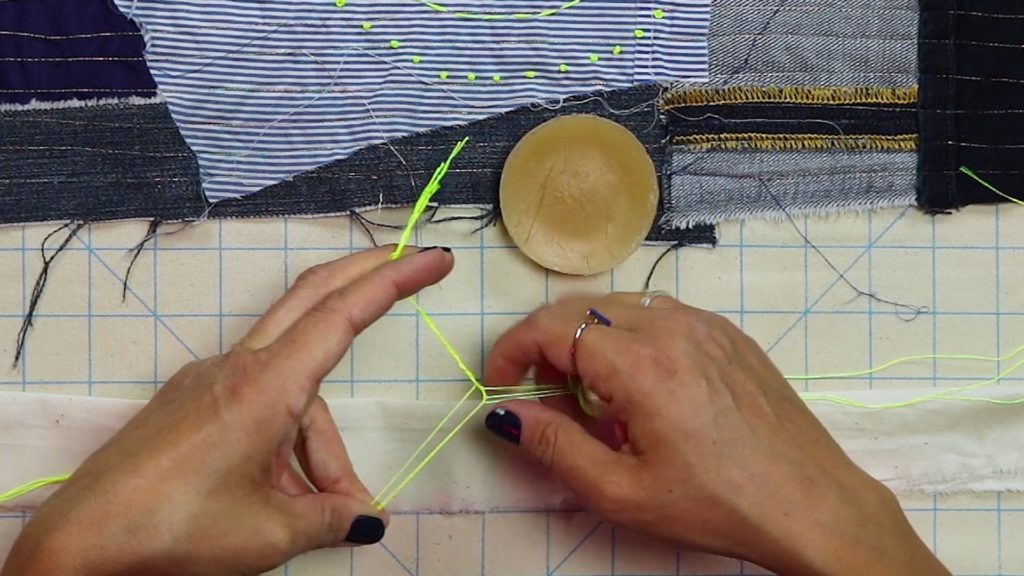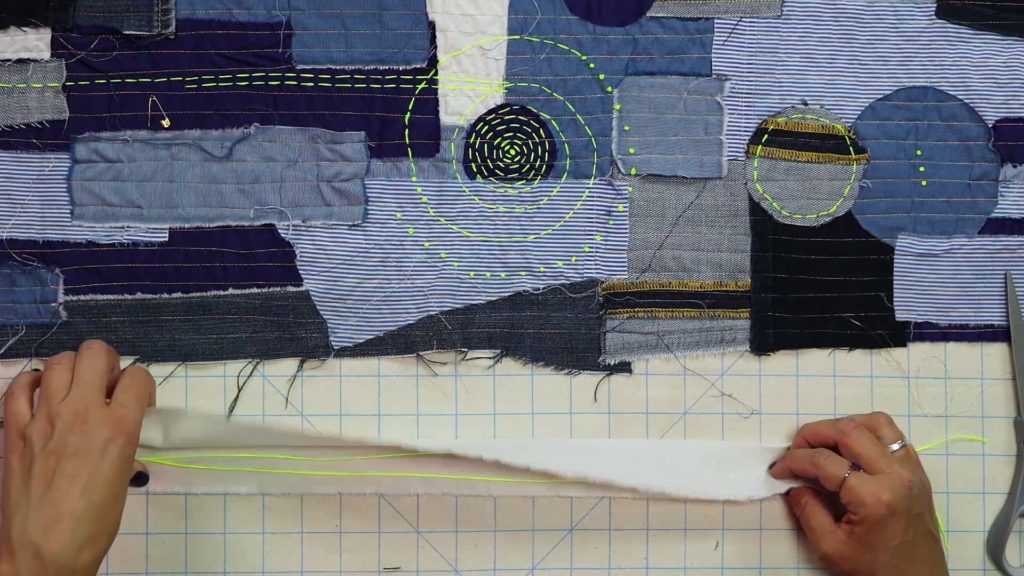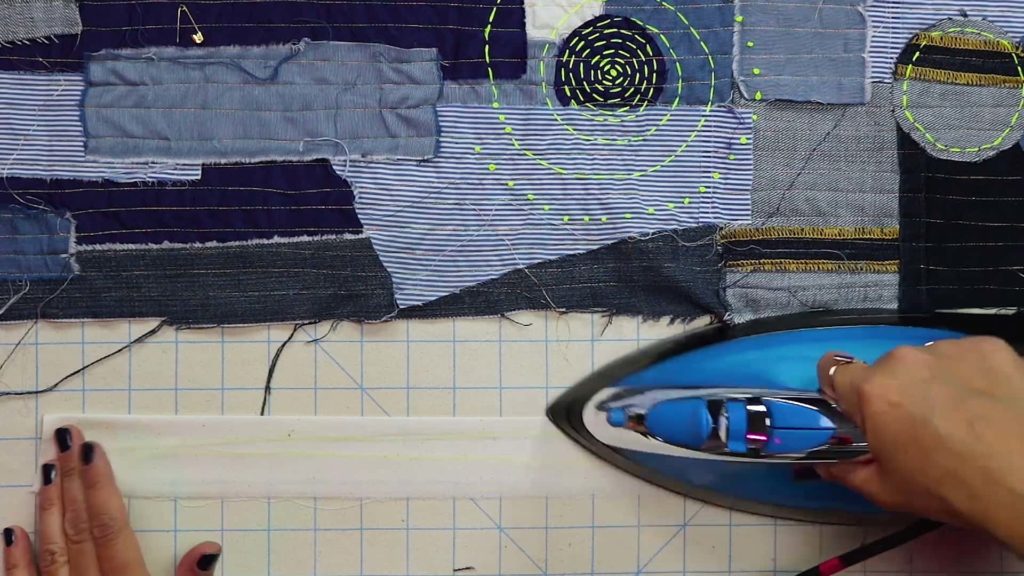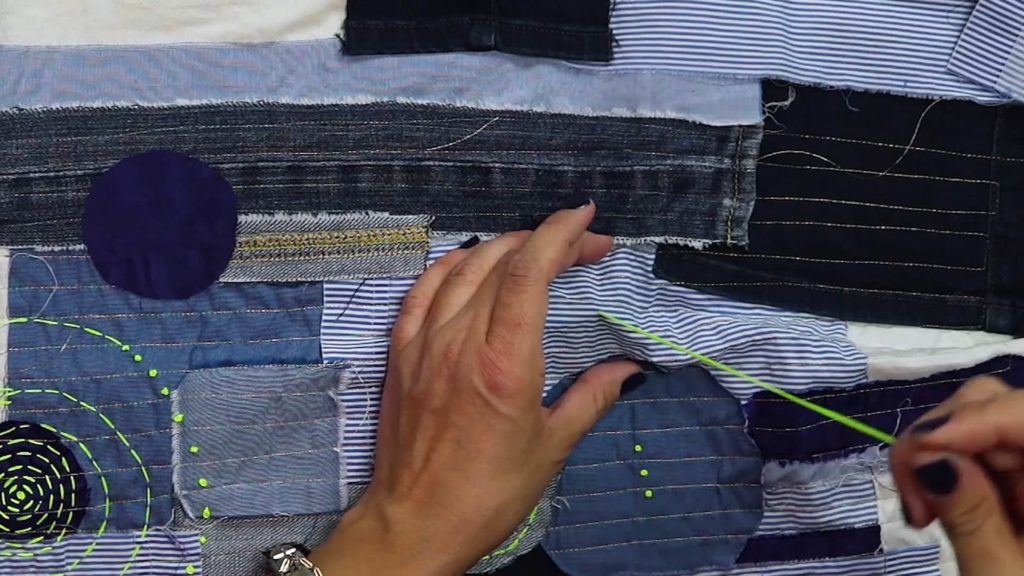Fashion Designer Extraordinaire Milda Bublys demonstrates how to sew sashiko embroidery stitches on patchwork to make old clothes look new!
Get this week’s free Quilting tools & classes bundle when you submit feedback Click here to learn more now
Sashiko, which translates “little stabs”, is a wonderfully meditative technique that gives visual and textural interest to garments, quilts, and accessories.
The modern objective of the stitch is decorative, and is also a brilliantly green form of upcycling. It is particularly popular on denim, giving it a bright pop of color.
Origins of necessity made fashionable
Traditionally, the sashiko method was used in Japan by poorer families that couldn’t afford new clothing. They’d use scraps from old worn-out clothes, patch them together, and work a running stitch over it.
So sashiko embroidery stitches stabilize one fabric to another. Typically the Japanese sewer would run a straight stitch across the entire length of the fabric, horizontally row by row.
Now we use glues and fusible interfacing to achieve this effect, but the technique is still popular because of it’s stunning visual appeal. It’s a vivid way to freehand stitch spirals, circles,flowers, stars, and french knots into otherwise plain textiles.
What you’ll need to hand sew sashiko embroidery stitches:
First off, some embroidery flosses separate easier than others, which is helpful in order to adjust the thickness of the stitch.

Select the number of strands to use and cut them at an angle to easily thread the eye of your needle. Separate them slowly and carefully to avoid tangling.
Then, run the embroidery floss through wax to bind the strands and to run easily through thick fabrics. Plus wax also makes it easier to thread your needle.

A wide-eyed embroidery needle will help with thicker fabrics and multiple layers, which is essential to patchwork. A thimble is highly recommended.
Finally, consider working with old or vintage fabrics to stay true to the origins of this artform. You can cover stains with your favorite applique, or use sequins for some added pizzaz.
Get Stitching!
- #1: To begin, iron the waxed embroidery floss between scraps of fabric to avoid getting wax on your iron.


- #2: Next, knot one end of the floss.
- #3: Now pull the needle up from the wrong side of fabric, so the knot is on the wrong side.

- #4: Sew a long stitch into right side, then a short gap into the wrong side. Repeat!
Be sure to catch all the layers when poking the needle through the fabric, and smooth the fabric between multiple stitches to keep it from ruffling.
Practicing the Art of Sashiko
Apparently the key to embracing this artform is learning to push the needle through the fabric with the thimble in a meditative flow, to repair, mend and strengthen the fabric (and your fingers)!
It’s an excellent technique to create highlights and images in a fabric collage. Some tips for mastery include:
- Maintain consistent space between the stitches.
- Don’t cross over stitches on the right side of the fabric.
- Right angles should not meet.
- Leave the center of shapes with cross-sections open.

Have you tried sashiko embroidery stitches on your clothes or quilts? Share in the comments section!
Get this week’s free Quilting tools & classes bundle when you submit feedback Click here to learn more now
Be great on blue jean jacket.
I’m glad you said about useing wax can you use wax on your thread when useing the sewing machine?
I need to purchase the machine
Love this technique! Can’t wait to try it on some of the things I’m doing for Christmas.
Were do you get the machine from and how much do it cost.
I tried it on an AG doll quilt for my granddaughter…my wax didn’t seem to help much…is there a way to warm the wax, make it more maleable???
Thanks for the fun idea
Sounds interesting and will try .Thanks for your help.
Can’t wait to try this. I have some clothes that I can try it on
Im a beginner sewer.so i have a lot to learn. Charlotte
You can use a bar of white bath soap instead of wax to make the thread easier to pull through. That’s what my grandmother use to do.
Love this look! Can’t wait to try on several items I have in mind. Could you also use the heavier pearl cotton thread?
This reminds me of when my mom first began to teach me to sew by hand. Of course, it never looked that good! Now I wish I had not given away all of my embroidery floss.
I have been sewing for a long time – I was taught to embroider when I was six but this teacher taught me a lot I didn’t know about preparing the threa that I never knew!